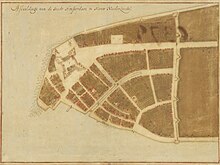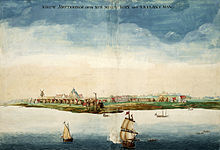The area of present-day Manhattan was originally part of Lenape territory.[1] European settlement began with the establishment of a trading post founded by colonists from the Dutch Republic in 1624 on Lower Manhattan; the post was named New Amsterdam in 1626. The territory and its surroundings came under English control in 1664 and were renamed New York after King Charles II of England granted the lands to his brother, the Duke of York.[2] New York, based in present-day Manhattan, served as the capital of the United States from 1785 until 1790.[3] The Statue of Liberty in New York Harbor greeted millions of immigrants as they came to America by ship in the late 19th century and is a world symbol of the United States and its ideals of liberty and peace.[4] Manhattan became a borough during the consolidation of New York City in 1898.
- ^ Burrows, Edwin G.; Wallace, Mike (1998). Gotham : a history of New York City to 1898. Mike Wallace. Oxford: Oxford University Press. pp. 6–7. ISBN 978-0-585-36462-9. OCLC 47011419.
- ^ "KINGSTON Discover 300 Years of New York History DUTCH COLONIES". National Park Service, U.S. Department of the Interior. Archived from the original on November 23, 2008. Retrieved April 7, 2018.
- ^ "The Nine Capitals of the United States". United States Senate. Archived from the original on March 20, 2016. Retrieved April 7, 2018.
- ^ "Statue of Liberty". World Heritage. UNESCO World Heritage Centre 1992–2011. Archived from the original on August 28, 2012. Retrieved April 7, 2018.


